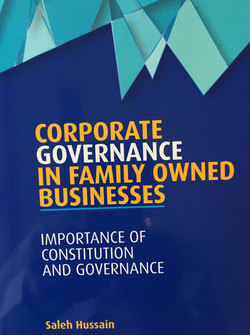Читать книгу Corporate Governance in Family Owned Businesses - Saleh Hussain - Страница 5
На сайте Литреса книга снята с продажи.
Chapter 1 Family Owned Business Defined
ОглавлениеThere is a need to define Family Owned business and there are difficulties to do that. The need to define is important to know in general terms, what it is we are talking about and what terminology we use and how people understand such terminology. Regulators too need to have a clear definition to ensure that relevant laws and regulations are directly linked to the right definition.
The difficulties revolving around the definition include whether the business owned by family members only or there are other owners from outside the family. Ownership and management perspective is another dimension to be considered in defining the FOBs. In western countries and USA other dimension relating to tax perspective is to be built into the definition.
Taking into account the above difficulties in coming up with the definition, we know that the Family Owned Business is defined in different ways in accordance with the way in which such business is looked at. Below are some definitions:
1.A business actively owned and/or managed by more than one member of the same family
2.An interaction between two separate but connected systems—the business and the family—with uncertain boundaries and different rules. Graphically, this concept can be presented as two intersecting circles. Family businesses may include numerous combinations of family members in various business roles, including husbands and wives, parents and children, extended families, and multiple generations playing the roles of stockholders, board members, working partners, advisors, and employees. Conflicts often arise due to the overlap of these roles. The ways in which individuals typically communicate within a family, for example, may be inappropriate in business situations. Likewise, personal concerns or rivalries may carry over into the work place to the detriment of the firm. In order to succeed, a family business must keep lines of communication open, make use of strategic planning tools, and engage the assistance of outside advisors as needed.
3.Family Firms are those in which multiple members of the same family are involved as major owners or managers, either contemporaneously or over time. (Miller, Le-Breton Miller, Lester, Canella, “Are Family Firms Really Superior Performers,” Journal of Corporate Finance, Vol. 13, Issue 5, 2007).
4.Family firms are those in which the family controls the business through involvement in ownership and management positions. Family involvement in ownership (FIO) and family involvement in management (FIM) is measured as the percentage of equity held by family members and the percentage of a firm’s managers who are also family members. (Sciascia and Mazzola, Family Business Review, Vol. 21, Issue 4, 2008).
5.A family enterprise is an economic venture (enterprise group) in which two or more members of a family (family group) have an interest in ownership (owners) and a commitment to the continuation of the enterprise.
6.The family business is a business governed and/or managed with the intention to shape and/or pursue the vision of the business held by a dominant coalition controlled by members of the same family or a small number of families in a manner that is potentially sustainable across generations of the family or families.
7.A firm of any size is a family business if:
i.The majority of decision-making rights are in the possession of the natural person(s) who established the firm, or in the possession of the natural person(s) who has/have acquired the share capital of the firm, or in the possession of their spouses, parents, child, or children’s direct heirs.
ii.The majority of decision-making rights are indirect or direct.
iii.At least one representative of the family or kin is formally involved in the governance of the firm.
iv.Listed companies meet the definition of family enterprise if the person who established or acquired the firm (share capital) or their families or descendants possess 25 percent of the decision-making rights mandated by their share of capital (European Union definition 2009).
8.A family business refers to a company where the voting majority is in the hands of the controlling family; including the founder(s) who intend to pass the business on to their descendants. The terms “family business”, “family firm”, “family company”, “family-owned business”, “family-owned company”, and “family-controlled company” will be used interchangeably throughout the Handbook to refer to family businesses. (Family Business Definition and Characteristics – Strengths and Weaknesses by: IFC Corporate Governance.)
9.The table below gives various types of FOBs based on ownership, management and family:
| No | Family | Ownership | Management | Comments |
| 1 | 1 family | 1 family | Same family | This type of family Business in most cases is a new or small company structure. |
| 2 | More than one family | 2 families and above | Owning Families | Two families or more get together and form a family business |
| 3 | One family or more plus a corporate /more than one corporate | Family(ies) plus corporate(s) | Jointly the family and corporate | In some cases in which family business faces a problem, teaming with others including corporations become an option. |
| 4 | Family Business / listed | Listed company | Professionally selected management | When FOB gets listed partially or wholly the name of the company may stay same or changed. The ownership spreads over many new owners who hold shares and they can change as purchase and sale transactions take place. |
